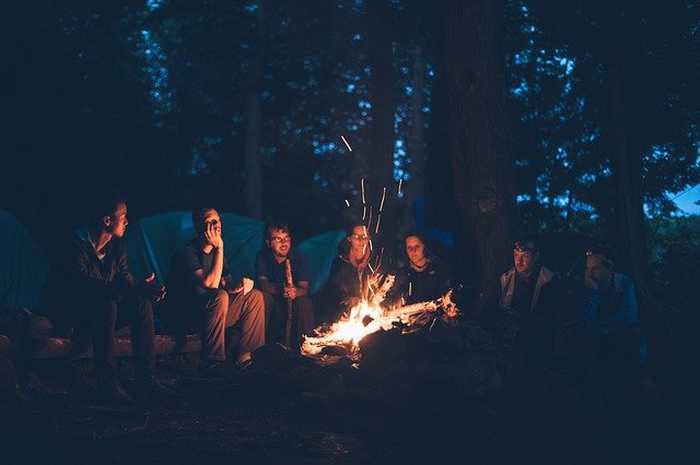When it comes to camping, there are pros and cons to both tents and hammocks. It really depends on your own preferences as to which is safer. Here we will explore the safety of both options so that you can make the best decision for your next camping trip.
Tents have been used for centuries as a reliable form of shelter when camping. They provide good protection from the elements and can be securely staked down to prevent them from blowing away in high winds.
Tents also offer some privacy, which can be important if you are sharing a campsite with other people. However, tents can also be hot and stuffy, especially in warm weather, and they can be difficult to set up if you don’t have much experience.
Hammocks are becoming increasingly popular as an alternative to tents for camping. They offer many of the same benefits as tents, including protection from the elements and privacy, but they are often more comfortable in warm weather due to the increased airflow. Hammocks can also be easier to set up than tents, although you will need two trees or other sturdy objects to anchor them too.
Is it OK to sleep in a hammock while camping?
Yes, it is perfectly fine to sleep in a hammock while camping! In fact, many campers find that sleeping in a hammock is more comfortable than sleeping on the ground. However, there are a few things to keep in mind if you want to get the most out of your hammock-sleeping experience.
First, make sure you choose a quality hammock. A good hammock will be made of sturdy materials and provide plenty of support for your back and body. Additionally, look for a hammock with mosquito netting if you’re worried about being bitten by bugs during the night.
Second, consider how you’ll be attaching your hammock to trees or other structures. You’ll need strong cords or ropes that can support your weight without breaking. Test out your setup before getting into the Hammock to make sure it’s secure.
Finally, remember that sleeping in a Hammock can take some getting used to! If it’s your first time trying it out, give yourself some time to adjust before expecting too much from the experience.
Are camping hammocks comfortable to sleep in?
When it comes to getting a good night’s sleep while camping, there’s nothing quite like sleeping in a hammock. Hammocks are incredibly comfortable, and when hung correctly, can be extremely secure and safe.
There are a few things to keep in mind when hanging your hammock for the first time. First, make sure you find two sturdy trees or posts that are about the same distance apart. Next, use straps or rope to securely attach the hammock at both ends. Once your hammock is hung, get in slowly and carefully, making sure that it is evenly balanced before lying down.
Once you’re settled in, enjoy the gentle rocking motion of the hammock as you drift off to sleep.
Is a hammock more comfortable than a tent?
There are a few factors to consider when trying to decide if a hammock or tent is more comfortable. One is how you sleep. If you sleep on your side, then a hammock may be more comfortable because it will mold to your body. If you sleep on your back, then a tent might be better because it will provide more support.
Another factor is the weather. If it’s hot outside, then a hammock will likely be more comfortable because it won’t trap heat like a tent can. On the other hand, if it’s cold outside, then a tent will probably be better because it will provide warmth and protection from the elements. Ultimately, it comes down to personal preference and what works best for you in different situations.
What is the most comfortable thing to sleep on in a tent?
There are a few things you can do to make sure you’re comfortable while sleeping in a tent. First, put down thin foamies or very thick woolen blankets under your air mattress on the bottom of the tent. This will help insulate you from the cold ground.
Then, top your air mattress with thick wool blankets and cover it with a fitted sheet to keep everything in place. You might also want to consider investing in a Sleeping Bag Liner, which is an extra layer of insulation that goes inside your sleeping bag.
Is hammock camping safer than tent camping?
Hammock camping has its own unique set of challenges, but it can be just as safe as tent camping if you take the proper precautions. A hammock alone provides less protection from the elements than a tent, so you’ll need to bring along a large tarp, guy lines, and stakes to stay dry.
To stay warm, you’ll need an underquilt or foam sleeping pad. And don’t forget the bug netting – you’ll want to keep the mosquitos away! With a little bit of planning and preparation, hammock camping can be a safe and enjoyable experience.

Are hammocks uncomfortable?
Yes, you can sleep in a hammock. However, the quality of your sleep and your comfort throughout the night depend largely on the type of hammock that you use. A quality hammock for sleeping will also ensure that you don’t experience any back pain or other discomfort during the night.
There are two main types of hammocks: those with spreader bars and those without. Spreader bar hammocks are generally more comfortable for sleeping, as they provide a more level surface to lie on. Hammocks without spreader bars can be uncomfortable as they tend to cup your body and can cause you to feel like you’re going to roll out of them during the night.
If you do decide to sleep in a hammock, make sure to choose one made from breathable fabric so that you don’t get too hot during the night. You may also want to consider using a camping pad or pillow for additional comfort and support.
Will Bears bother you in a hammock?
No, bears will not bother you in a hammock. As long as your food scents are away from your campsite and you aren’t hanging a bear bag from your hammock, you’ll be just as safe as you would be camping in a tent.
Is it safe to sleep in a hammock while camping?
Yes, it is safe to sleep in a hammock while camping as long as you set it up properly and securely. If hanged correctly, a hammock can actually be even safer than traditional tent camping. With a hammock, you are elevated off the ground which helps avoid ground moisture, creepy crawlers, and even rainwater. Additionally, sleeping in a hammock is good for your backbone and posture.
Is hammock camping safe from animals?
One of the natural advantages of camping in a hammock is that you are suspended off the ground. This means smaller animals will have a much more difficult time getting into your shelter at night. Coupled with a bug net, a hammock will keep you safely suspended above any raccoons squirrels or snakes passing by.
So, yes, Hammock camping is safe from animals – as long as you take some basic precautions to protect yourself from insects and other pests.
Are tents or hammocks safer?
There is no clear-cut answer to the question of whether tents or hammocks are safer. Both have their pros and cons when it comes to safety.
Tents offer more protection from the elements than hammocks, but they can also be more difficult to set up properly. Hammocks are easier to set up, but offer less protection from the wind and rain.
It is important to consider your own needs and preferences when deciding which type of shelter is right for you. If you are camping in an area with severe weather conditions, a tent may be the better option. If you are looking for a lighter-weight shelter that is easy to set up, a hammock may be the way to go.
Is a tent or hammock better for camping?
Hammock camping has become increasingly popular in recent years, due largely to the many advantages it offers over traditional tent camping. For starters, hammocks are far more comfortable to sleep in, thanks to the lack of contact with the ground and the ability to adjust your position however you like. This also makes them ideal for relaxing in during daylight hours; there’s nothing quite like swaying gently in a hammock on a warm summer day!
Another big advantage of hammocks is that they’re much easier and quicker to set up and take down than tents. This is especially useful if you’re camping in an area where finding level ground can be difficult, or if you need to move camp frequently. And since there’s no need for poles or stakes, you can save a lot of weight by choosing a lighter-weight hammock instead of a tent.
Are hammocks comfortable for side sleepers?
Yes, hammocks can be just as comfortable for side sleepers as they are for back sleepers. The key is to get a double hammock and hang it with a 30-degree sag. This will create a flatter surface that’s more comfortable for side sleeping. Additionally, you’ll want to sleep diagonally across the hammock rather than along the length of it.
Are camping hammocks worth it?
Hammock camping is becoming increasingly popular, as it offers a more comfortable and enjoyable experience than traditional camping. It is also easier to setup and take down, without the sacrifices often associated with ultralight or minimalist gear. However, convincing yourself to head out into the woods without the one thing that has always been a part of your camping experience (a tent) can be difficult. Here are some things to consider when deciding whether hammock camping is right for you:
Comfort: Hammocks offer a much more comfortable sleeping experience than tents, as they conform to your body and distribute your weight evenly. This means you won’t have any uncomfortable pressure points, and you’ll be able to sleep better overall.
Enjoyment: Camping in a hammock also allows you to enjoy your surroundings more. You can set up your hammock anywhere there are two trees (or other support structures), which gives you a lot of flexibility in where you camp. And, since you’re not confined to a small space inside a tent, you’ll feel like you’re really immersed in nature.
Ease of use: Hammocks are very easy to setup and take down – all you need is two trees (or other support structures).








